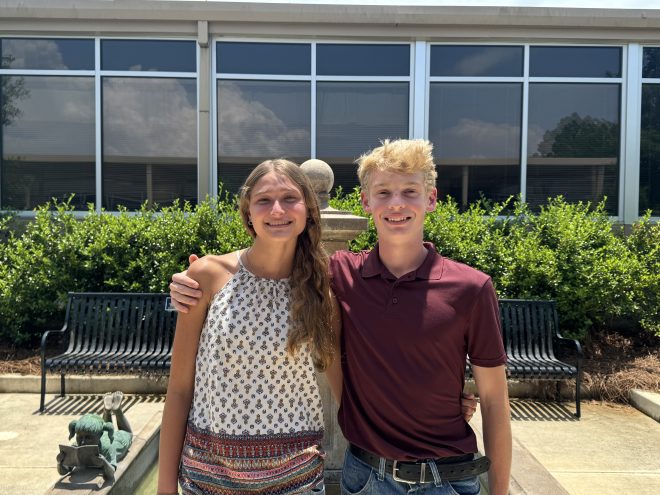Plant for pollinators!
Published 9:07 am Monday, April 17, 2023

- THE PERFECT WAY TO ATTRACT WILDLIFE: Planting native milkweed plants attract Monarchs and signal to the butterflies that by the end of their blooming period, they should move further south.
“Spring flowers are nature’s most fragrant charms.” — Angie Weiland-Crosby.
“What a lonely place it would be to have a world without a wildflower!” — Roland R. Kemler.
“Spring unlocks the flowers to paint the laughing soil.” — Bishop Reginald Heber.
“In the Spring, I have counted 136 different kinds of weather inside of 24 hours.” – — Mark Twain.
“Some old-fashioned things like fresh air and sunshine are hard to beat.” — Laura Ingalls Wilder.
“A flower blossoms for its own joy.” — Oscar Wilde.
“My favorite weather is bird chirping weather.”-— Terri Guillemets.
The colorful posters with a collection of common herbs are a popular social media share. Save the bees, they say; plant these. In case someone has missed the memo, pollinators in general are struggling. Pollinators are nature’s matchmakers, working together with plants – in many cases interdependent – to ensure the plant’s reproduction. In exchange for matchmaking services – moving pollen, the male plant essence, to female plant organs, pollinators are enticed with flower nectar, which is carbohydrate flight fuel, and pollen, a source of protein or food. Pollinators need plants, their future is intertwined with having a wide variety of pollen and nectar sources. If we want to help one, we need to address both. What can we all do to successfully plant for pollinators?
Be Kind to Soil: Most of us pick up a bag of topsoil at our local garden center and call it good but soil is so much more than that. There are millions of different mycelium and miniscule creatures living at varying soil temperatures and conditions – something like one tablespoon holds more living forms than people currently populating earth. and not all plants survive in the same kind of soil. regardless of what you see online. Some plants will only thrive in very specific growing conditions, such as tree bark. Soil, in general, is 45% inorganic, 25% water, 25% air, and 5% decomposing organics with living organisms.
Recycle Food: We waste about 40% of the food we buy so why not recycle it? Two parts brown or dried food to one part green. Add water. Toss and let decompose in a dark container until black and crumbly. Mix with existing soil to feed soil microorganisms and plants. Don’t call it composting. For some reason, that is too complicated for some people and it doesn’t have to be. How to start? Add a plastic bag to your freezer bin and toss leftovers in there. When full, take it outside and bury it in a flower bed to feed your soil residents keeping plants healthy. You’ll be in a small composter in no time.
Collect Rain: Most of us have gutters on our houses, it’s a simple tweak of a spout and a hardy receptacle of some sort and you can collect rainwater. Potted plants on decks prefer rainwater to the treated city water. Repurposed 55-gallon totes make handy water storage containers and a simple sump pump can help deliver the water where you need it. Harness what is already getting delivered through a gutter system instead of letting the water wash away precious soil.
Reduce Turfgrass: We have the equivalent of the state of Texas in planted turf grass in the US, an expensive lawn covering that is expensive to establish, and maintain, with no redeeming quality as far as the ecosystem is concerned. Luckily there are alternatives being developed that still provide a green expanse with low-growing flowering plants that can provide pollinators with food and flight fuel. Living in a smaller space? Add a bird bath to a corner. Let it collect rainwater and keep it full through the growing season.
Know Your Pollinators: We love the pollinator poster child, the Monarch butterfly. Some even try to hand-raise them but studies show if you want to help Monarch butterflies, best to plant native milkweed for them. How about flies, bats, and wasps, they are also specialty local pollinators unique to an area. and we’re only too happy to try to get rid of what we don’t understand. Take tomato hornworms, the bane of most tomato gardeners. and yet that hungry caterpillar turns into a lovely hawk moth, a nocturnal pollinator. Take a step back and rethink some of those bad habits. and question some of the native lore about what is, or isn’t, good in our gardens.
Welcome Birds: Instead of using pesticides, hang birdhouses. Some 60% of all birds depend on caterpillars and undesirable garden bugs for baby bird food. When we drop a can of pesticide on that wasp nest in the deck corner, you know you’re going to miss and, in the process, contaminate your own living space with harmful chemicals. Instead of over-using chemicals, focus instead on encouraging birds into gardens, you may be surprised at who else moves in.
Use Decoy Plants: There are also plants that work well as decoys. Delicious nasturtiums, for example, are not only edible by us but aphids like them, too. Plant nasturtiums to decoy aphids from tender vegetables such as cabbage and to protect roses. Use them in hanging baskets to easily move around for their bug patrol.
Embrace Natives and Nativars: Not only are some pollinators unique to a particular location but so are the native plants that depend on them. Native trees, shrubs, and flowers have evolved intricate relationships with native pollinators that other plants can’t fill. If a plant is not available, then the pollinator can’t thrive or survive. Remember the big push years ago to plant for Monarch butterflies? Someone forgot to mention not to plant tropical milkweed, which was keeping Monarchs from migrating south before the weather turned cold. By focusing on planting native milkweed plants instead, the native plants not only had a limited blooming period but the end of their blooms signaled to the Monarchs it was time to keep moving south.
Keep Planting: Rethink that open space you have and put it to good use by planting native trees. Trees will by far provide the most flowers per square inch and native trees will do well planted in their native soil and growing conditions. Incorporate a raised bed for favorite vegetables and let native flowers growing nearby entice pollinators to increase your food yield. As more land is taken out of native habitat and turned into housing, we need to compensate by planting more on what land remains.
The Right Time: You can have the best combination of soil and plant species but if the time isn’t right for the plant, nothing is going to happen. Plants focus on reproduction when their surrounding conditions are supportive – sunny, windless days with temperatures between 74F and 86F. It’s like getting ready for a date, the plants want excellent conditions so they can focus energy on regenerating. When temperatures start to head north of 86F, plants shift from reproduction to survival. Know what the temperature trends are in your area and identify the most likely best times for your plants to reproduce. That’s when they will attract pollinators with a range of sweet nectar.
Our gardens are someone’s home and should be shared with other creatures. We should strive for balance, not perfection. Our healthy gardens are a busy place with bugs on flowers, birds flying overhead and insects moving across the soil, each with their own food source and nesting needs met. Enjoy your gardening this season and may your harvest be blessed! This fact sheet is provided as an educational service of the National Garden Bureau at www.ngb.org/10-tips-for-for-pollinator-planting sand Charlotte Ekker Wiggins.
“So then, just as you received Christ Jesus as Lord, continue to live in Him, rooted and built up in Him, strengthened in the faith as you were taught, and overflowing with thankfulness.” Colossians 2:6. “These [religious rules about what you eat and drink, keeping festivals and special Sabbath days] are a shadow of the things that were to come; the reality, however, is found in Christ.” Colossians 2:17. “I have come into the world as a Light, so that no one who believes in Me should stay in darkness.” John 12:46. “You call me ‘Teacher’ and ‘Lord,’ and rightly so, for that is what I am. Now that I, your Lord and Teacher, have washed your feet, you also should wash one another’s feet. I have set you an example that you should do as I have done for you.” John 13:13-15.





